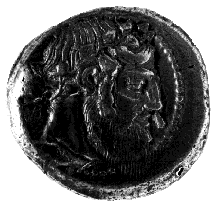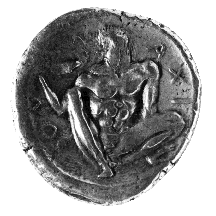



(14) Naxos, Sicily (Italy) - AR tetradrachm, c. 460 B.C.,
17.49 g. (inv. 93.004).
Obverse: Head of bearded Dionysos r., wearing ivy wreath.
Reverse: Seated Silenos holding kantharos in r.;
![]() : of the Naxians.
: of the Naxians.
Provenance: Ex Rosen collection; Harlan Berk, 1991.
Bibliography: C.M. Kraay, Archaic and Classical Greek
Coins (Berkeley and Los Angeles 1976) 217-218.
Naxos was the earliest Greek colony in Sicily, founded by Chalkis in 735
B.C. (Thucydides, History 6.3). Its mint also produced some of the
earliest coins in Sicily. The Dionysiac types on its coins reflect the mainstay
of its economy, the production of wine.
In 476 B.C. the Naxians had been forced to move to Leontinoi by the tyrant
Hieron of Syracuse, but after the fall of the tyranny they returned home
c. 461 B.C. The coins that they issued upon their return are considered
among the masterpieces of Greek coinage. Only a single pair of dies was
made for these coins, of which some 50 examples survive. The obverse depicts
a finely detailed head of the wine god Dionysos, and the reverse Silenos,
one of the imbibing part-man, part-animal followers of Dionysos. Silenos
here has shaggy hair, horse's ears, and a tail. He sits in an undignified
squat as he prepares to drink from the kantharos or wine-cup in his
right hand. The radical foreshortening of his right leg and foot and the
detailed musculature of his torso are comparable to the treatment of the
best large-scale sculpture of the period.
C.L.L.



All contents copyright (c) 1996.
Lawrence University
All rights reserved.